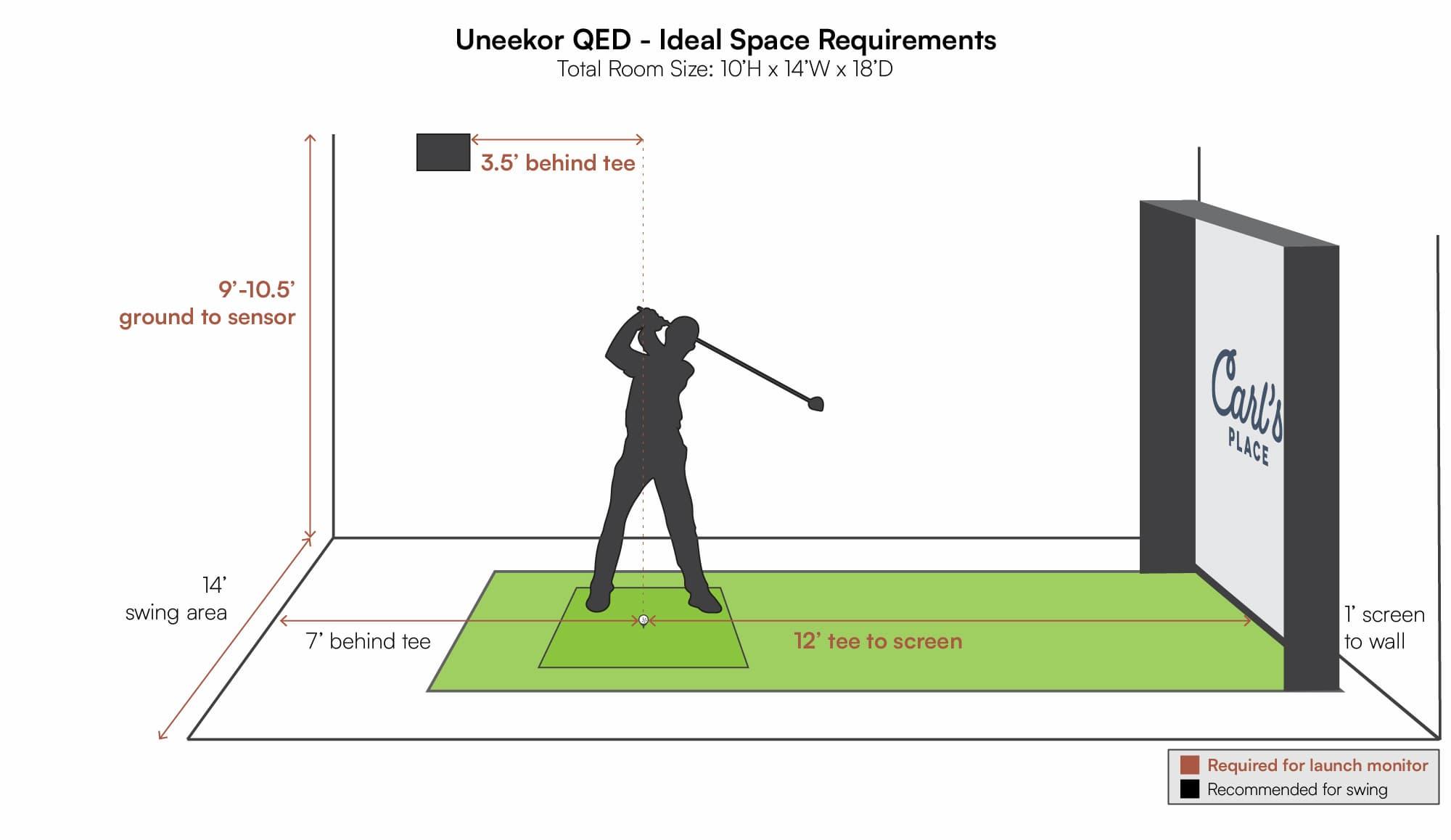2. Width
The swing area to the left and right of the tee is also important. If you want your tee in the center of the simulator, or have both right- and left-handed friends, you’ll need a wider golf simulator room. If you don’t have a lot of width in your golf room, you can offset your tee, and get away with a smaller space
How wide should my golf simulator be?
To golf indoors, you need a room at least 9′-10’ wide. But, if you want your tee centered in the golf simulator (to accommodate both right- and left-handed golfers) you’ll need a space at least 14′ wide. Ultimately, make sure you have enough room to swing without hitting a wall.
3. Depth
Easily one of the most debated topics for golf simulators is how much depth you need. Often times the launch monitor you use in your golf simulator room will dictate the dimensions you need. Or vice versa, you’ll need to choose a launch monitor, based on the golf simulator room dimensions you have available.
Regardless, the ideal depth for a golf simulator room includes:
- Space from the tee to the impact screen
- Buffer space behind the screen
- Room to safely swing
How deep should my golf simulator be?
18′ is the ideal depth for a golf simulator room. Here’s how we get that. Your impact screen should be 12″-16” away from the wall behind it. Then, it’s a best practice to place your tee 10′-12′ away from the impact screen. Lastly, give yourself 7′ behind the tee to swing easily.
In total, 18′ deep is ideal for a golf simulator room. That being said, we often see golfers set up simulators in spaces that are 15′ deep or shallower. Don’t get too shallow though – you’ll find yourself compromising on buffer space, swing space, or the space between tee and screen. That’s when you need to be careful and make sure your setup is safe. We really don’t want you to have golf balls ricocheting directly back at your head.
If you do have a small simulator space, let us know! We’ll see what we can do to help get you your perfect setup.
Another thing most golfers set up in their simulator is a projector. Choosing a projector for a golf simulator can be a challenge. There are specifications for the distance a projector can project an image, so make sure you’re reviewing the specs on your projector as well.
Now, you can DIY a golf simulator with dimensions that fit all of these requirements. Or, you can use an enclosure kit. Carl’s Place sells 2 main types. Our DIY Golf Simulator Enclosure Kit for home golf simulators. And our Pro Golf Simulator Enclosure Kit for high-end home or commercial setups.
Either way, you’ll get an easy-to-install, easy-to-fit golf simulator. Sounds fantastic, right? Here’s some extra help on how to choose the best enclosure size and the different screen finishes we can customize for you.
How much room do you need for a golf simulator?
It’s all about your swing. Many golfers feel good golfing in a 10’H x 14’W x 18’D golf simulator. Some fit golf simulators into a more compact space, but most indoor golfers go as large as they can with the space they have.
Also, before you buy, read the directions on your launch monitor. Yep, we said it – Read. The. Directions.
The launch monitor is what reads your swing and/or your ball to give you an idea of how you did. Each launch monitor has certain space requirements in order to do that.
Get to the launch monitor page. Open that user manual. Check the setup and space needs. You’ll thank us later.
Fitting a Golf Simulator Into a Small Space
Don’t let a smaller space hold you back from enjoying the thrills of an indoor golf simulator. In fact, many enthusiasts have had to get creative with their layouts.
Before investing in a simulator, it’s important to test out your space by taking a few swings with different clubs to ensure you have enough room to swing comfortably. While some golfers can get by with 8-foot ceilings, taller players or those with a more upright swing may require a minimum of 10 feet or more.
Additionally, make sure to leave at least a foot of space behind the impact screen and three inches on each side of the enclosure for buffer space. We recommend a minimum of 10 feet from the screen to the ball, with an additional 7 feet behind the ball for optimal swing space.
If space is limited, you may be able to get away with a minimum width of 10 feet, but be prepared to offset your hitting area from the center of the room as this will allow for a comfortable backswing and follow through. A launch monitor with offset hitting settings can be helpful, but remember to test out your space before making any purchases.
Planning Your Space for a Commercial Golf Simulator
When designing a commercial space for golfers, it’s crucial to plan out each hitting station to determine how many enclosures can fit comfortably.
Aim for a minimum height of 10 feet to accommodate all swings, and consider the number of bays required for your needs. If you plan to cater to both lefties and righties in the same bay, allow for a wider space of at least 14 feet for comfortable swings.
However, if only one side (right handed or left handed) will be used, you can create a smaller bay with a minimum of 7 feet of space behind the golfer. Keep in mind that deeper bays can offer more safety, and that enclosure wall wear can be an issue if one side is used more often.
All these factors must be considered when deciding on the number of bays and their positioning.
Get more tips for starting an indoor golf business.
Golf Simulator Space Requirements
Let’s look at the golf simulator space requirements for popular launch monitors.
Jump to: Uneekor QED | EYE XO | EYE XO2 | EYE Mini | Mevo+ | SkyTrak | Garmin R10 | Bushnell Launch Pro | GC3 | GC Hawk | Falcon | GCQuad | Full Swing KIT
Uneekor QED Space Requirements
The QED is an overhead golf launch monitor that you can mount to a Carl’s Place Pro Enclosure, or your ceiling. Ceiling-mounted launch monitors typically let golfers feel more comfortable swinging in the golf simulator hitting area.


